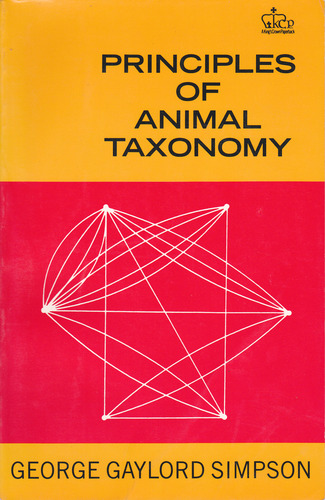Principles of animal taxonomy book download
Par stlouis june le samedi, août 20 2016, 01:36 - Lien permanent
Principles of animal taxonomy by George Gaylord Simpson


Principles of animal taxonomy George Gaylord Simpson ebook
ISBN: 023109650X, 9780231096508
Publisher: Columbia University Press
Format: djvu
Page: 131
French, German, Russian, and other languages do not have to accord with English ways of splitting up animals. A broader taxonomic distribution has been reported for vocal convergence, where the acoustic properties of calls from different individuals converge when they are housed together in captivity or form social bonds in the wild. The first significant definitions were developed by Aristotle. They then turn to taxonomy, as they study increasingly complex types of animals. Vocal convergence Unique Identifier: 2008-11209-011; Title: Convergence of calls as animals form social bonds, active compensation for noisy communication channels, and the evolution of vocal learning in mammals. With Darwin's theory, a general acceptance that classification should reflect the Darwinian principle of common descent quickly appeared. Tree of Life representations became popular in scientific works, with known fossil groups incorporated. We shouldn't smuggle taxonomic principles into everyday language to make a political argument. English words do not need to be monophyletic. ( nonchordates up to phylum level and chordates up to class level). His works, Tempo and Mode in Evolution (1944) and Principles of Classification and a Classification of Mammals (1945), were particularly instrumental in this respect. While he continued throughout his lifetime to revise and expand this great work, so his successors have continued to revise the principles of taxonomy, now according to genetic principles, informed by the analysis of DNA. Scientifically, it is called taxonomy and rooted in ancient Greek. Taxonomy is international -- everywhere, we recognize that humans are hominoids. The system that we still use today for giving scientific names to plants and animals has many founders, from the Greek philosopher Aristotle to the Swedish physician and botanist Carolus Linnaeus. Principles of animal communication. Taxonomic aids, keys, specimen management ; Systematic and binomial system of nomenclature; Classification of living organisms( five kingdom classification, major groups and principles of classification within each group) Salient features of animal? Structural organisation in plants and animals. This course begins with an overview of key concepts in zoology as students examine the characteristics of the animal cell and discuss heredity and issues of evolution, including natural selection. From microscopic investigation to the basics of veterinary medicine, Zoology covers principles of comparative animal anatomy, physiology, and genetics.